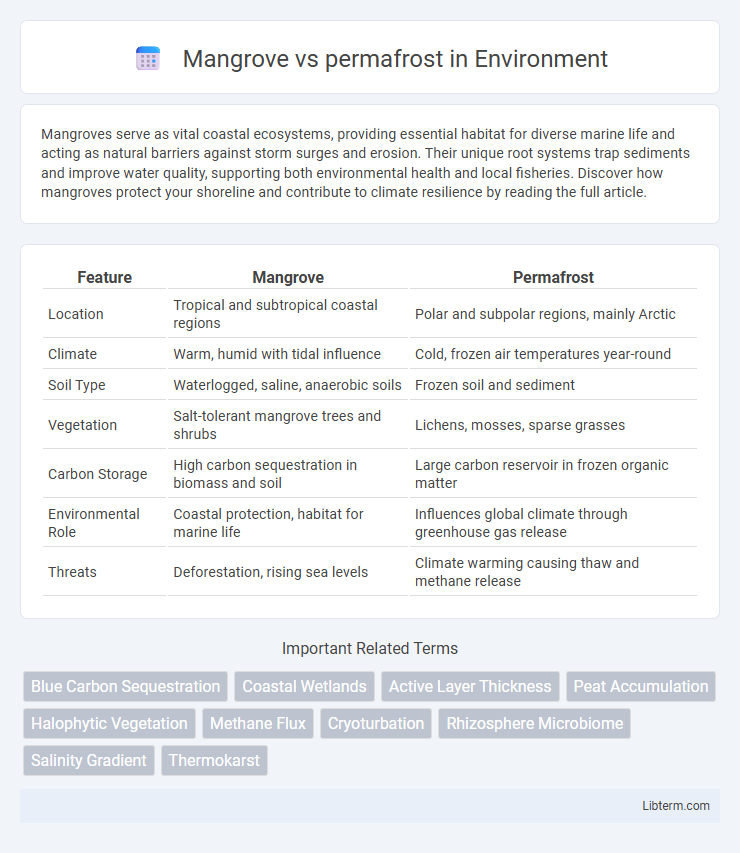Mangroves serve as vital coastal ecosystems, providing essential habitat for diverse marine life and acting as natural barriers against storm surges and erosion. Their unique root systems trap sediments and improve water quality, supporting both environmental health and local fisheries. Discover how mangroves protect your shoreline and contribute to climate resilience by reading the full article.
Table of Comparison
| Feature | Mangrove | Permafrost |
|---|---|---|
| Location | Tropical and subtropical coastal regions | Polar and subpolar regions, mainly Arctic |
| Climate | Warm, humid with tidal influence | Cold, frozen air temperatures year-round |
| Soil Type | Waterlogged, saline, anaerobic soils | Frozen soil and sediment |
| Vegetation | Salt-tolerant mangrove trees and shrubs | Lichens, mosses, sparse grasses |
| Carbon Storage | High carbon sequestration in biomass and soil | Large carbon reservoir in frozen organic matter |
| Environmental Role | Coastal protection, habitat for marine life | Influences global climate through greenhouse gas release |
| Threats | Deforestation, rising sea levels | Climate warming causing thaw and methane release |
Introduction to Mangroves and Permafrost
Mangroves are coastal ecosystems characterized by salt-tolerant trees and shrubs thriving in tropical and subtropical tidal areas, crucial for carbon sequestration and shoreline protection. Permafrost refers to permanently frozen ground found in polar and high-altitude regions, playing a vital role in regulating global climate by storing large amounts of organic carbon. Both ecosystems are essential components of the Earth's biosphere, influencing biodiversity, climate regulation, and environmental stability.
Geographic Distribution and Ecosystem Overview
Mangroves are tropical and subtropical coastal ecosystems primarily found along shorelines of Southeast Asia, Africa, Australia, and the Americas, where salt-tolerant trees thrive in intertidal zones. Permafrost regions exist in high-latitude areas such as Siberia, Alaska, and northern Canada, characterized by permanently frozen soil that supports tundra ecosystems with limited vegetation. These distinct geographic distributions shape unique ecosystems: mangroves serve as nurseries for marine species and protect coastlines from erosion, while permafrost maintains carbon storage and affects groundwater flow in cold environments.
Key Environmental Roles of Mangroves
Mangroves play a crucial role in coastal ecosystems by stabilizing shorelines, reducing erosion, and providing habitat for diverse marine species. They act as significant carbon sinks, sequestering large amounts of atmospheric CO2, which helps mitigate climate change. Unlike permafrost, which stores carbon in frozen soil vulnerable to thawing, mangroves actively maintain carbon storage through organic matter accumulation and nutrient cycling.
Core Functions of Permafrost Regions
Permafrost regions regulate global climate by storing nearly 1,500 gigatons of organic carbon, preventing large-scale greenhouse gas release. These frozen soils support unique Arctic ecosystems that maintain biodiversity and provide critical habitat for species like the Arctic fox and caribou. Permafrost also stabilizes infrastructure and ecosystems by maintaining soil integrity, controlling hydrological cycles, and regulating nutrient flow essential for plant growth and carbon sequestration.
Biodiversity in Mangroves vs. Permafrost
Mangroves support exceptionally high biodiversity, providing critical habitats for numerous fish, crustaceans, birds, and plant species adapted to saline and waterlogged conditions. Permafrost regions harbor specialized, cold-adapted organisms such as mosses, lichens, and microbial communities, but overall species diversity is lower compared to mangrove ecosystems. The structural complexity and nutrient cycling in mangroves foster greater species richness and ecological interactions than the more extreme and nutrient-poor permafrost environments.
Carbon Sequestration: Mangrove vs. Permafrost
Mangroves sequester carbon at rates up to four times higher than most terrestrial forests, storing large amounts of carbon in their dense root systems and submerged sediments. Permafrost soils contain nearly twice as much carbon as the atmosphere, but thawing due to climate change releases this stored carbon as greenhouse gases. Mangrove ecosystems actively lock carbon away in biomass and sediments, while permafrost's carbon sequestration is primarily passive and threatened by warming temperatures.
Climate Change Impact on Mangroves and Permafrost
Climate change accelerates the degradation of mangroves and permafrost, destabilizing coastal ecosystems and releasing significant greenhouse gases. Rising temperatures cause permafrost thaw, releasing methane and carbon dioxide, while sea-level rise and increased storm intensity threaten mangrove habitats. Both ecosystems' decline disrupts carbon storage capacity, exacerbating global warming and biodiversity loss.
Human Activities and Conservation Efforts
Human activities such as deforestation, coastal development, and pollution have significantly impacted mangrove ecosystems by reducing their area and disrupting their ecological functions, while permafrost regions face challenges from infrastructure development and resource extraction that accelerate thawing and greenhouse gas emissions. Conservation efforts in mangrove areas emphasize afforestation, sustainable management, and community-based protection to enhance biodiversity and carbon sequestration. In contrast, permafrost conservation focuses on monitoring thaw rates, regulating industrial activities, and implementing climate mitigation strategies to preserve soil stability and reduce the release of trapped methane and carbon dioxide.
Adaptation Mechanisms and Ecosystem Resilience
Mangroves adapt to saline and waterlogged environments through specialized root structures like pneumatophores that facilitate gas exchange and salt filtration, enhancing ecosystem resilience by stabilizing coastlines and supporting biodiversity. Permafrost ecosystems rely on thermal insulation by vegetation and organic layers to maintain soil temperatures below freezing, enabling microbial communities that regulate nutrient cycling despite harsh conditions. Both systems exhibit unique adaptation mechanisms that buffer environmental stressors, promoting long-term ecosystem stability amid climate change impacts.
Conclusion: Future Outlook for Mangroves and Permafrost
Mangroves and permafrost both play critical roles in carbon sequestration but face distinct challenges due to climate change. The expansion of mangroves in some regions may enhance coastal carbon sinks, while permafrost thaw accelerates greenhouse gas emissions, exacerbating global warming. Protecting mangrove ecosystems and stabilizing permafrost areas through targeted conservation strategies is essential for mitigating climate impacts and preserving biodiversity.
Mangrove Infographic

 libterm.com
libterm.com